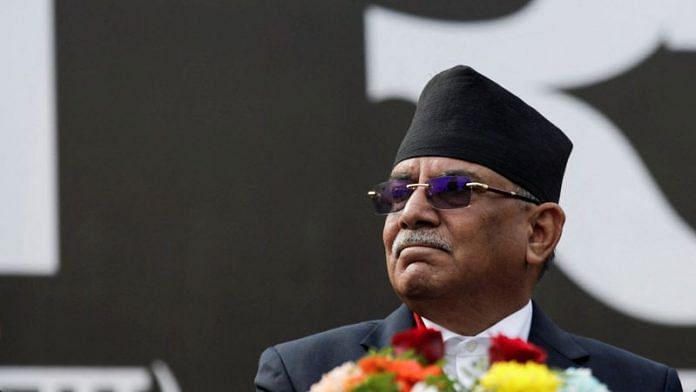Politics in Nepal, the former Himalayan Kingdom, is as unpredictable as the mountain weather and never short of surprises. Although, the fractured mandate of the 2022 general election held in November – and the change of mind of leaders switching alliances is surely a surprise.
It was a contest between former prime ministers of Nepal. Sher Bahadur Deuba’s Nepali Congress (NC) emerged as the single-largest party with 89 seats. K.P. Sharma Oli’s United Marxist Leninist (UML) managed 78 seats. Pushpa Kamal Dahal aka Prachanda’s Communist Party of Nepal-Maoist Centre (CPN-MC) got 32 seats. Nepal’s Lower House has 275 members – 165 directly elected and 110 nominated by the parties on a proportional basis depending on the number of votes polled by each.
Deuba’s NC and Prachanda’s CPN-MC were part of a five-party coalition that got 136 seats, two short of a majority to form the government. But talks between Deuba and Prachanda broke down on accusations by the latter that the former went back on the pre-poll agreement of sharing the prime minister’s post.
Politicians probably take the least time in burying hatchets. Once considered political adversaries, Prachanda and K.P. Oli quickly compromised on their differences and agreed for the former Maoist renegade to be the prime minister for the first half of the five-year term. It will not be surprising if Prachanda and Deuba decide to bury their hatchets to deny K.P. Oli the prime ministership in the second half.
Interestingly enough, Prachanda’s coalition consists of 24 members of the Rastriya Prajatantra Party (RPP), which strongly advocates for the restoration of the “Hindu Monarchy” and “Hindu Kingdom” status of Nepal, two promises it made in its manifesto. The Kamal Thapa-led RPP, the fourth largest party in parliament, was part of the pro-monarchy and anti-conversion rallies in 2020. A home ministry directive to all 77 districts asked for suppressing these rallies, using force if needed. The RPP, which was mentioned in the US Department of State’s 2021 report, was quick to sense the opportunity to cash in on the pro-monarchy sentiments.
Meanwhile, popular Bollywood star Manisha Koirala, granddaughter of the founder of Nepali Congress B.P. Koirala, campaigned for RPP saying, ‘The country needs monarchy….communal disharmony and exclusion of traditional and nationalist forces in the name of progressive politics has caused huge damage to the country.” Her charismatic campaign could be one of the reasons for the RPP to become the fourth largest party in parliament. If she decides to continue in politics in Nepal, it could spring more surprises in future. India should heavily invest in Nepal’s democracy and institution-building besides providing liberal developmental assistance.
Also read: Politics in Nepal has tilted in India’s favour now. 2017 elections was all about China
India matters more than China
For PM Prachanda, the delicate domestic balancing could be easier when compared to what he is expected to do in foreign policy. Among his first tweets after assuming office was commemorating Chairman Mao, the founder of People’s Republic of China, on his 129th birth anniversary. In his earlier avatar as PM in 2008, Prachanda had talked about preventing Tibetan refugees from entering Nepal and vowed not to tolerate “anti-China” activities on Nepal’s soil.
For all this bowing before Beijing, China’s Belt and Road Initiative (BRI) projects are still work in progress in Nepal. After the 2017 agreement, Kathmandu gave nine proposals which were discussed during Chinese President Xi Jinping’s Nepal visit in 2019. But the fear of Nepal walking into a debt trap has kept the projects in limbo. Meanwhile, Nepal’s parliament ratified a proposal for $500 million in Millennium Challenge Corporation (MCC) grant assistance from the United States.
As if to counter US influence, China agreed to give Nepal access to Chinese ports, including Tianjin, Shenzhen, Lianyungang and Zhanjiang, and allow Nepalese goods to have access to dry ports at Lanzhou, Lhasa and Xigatse, besides inland transit through China. But none of these logistics are practical because the goods will have to cover more than 3,000 km, making trade unviable. Yet, New Delhi should be concerned about the extension of Qingzang Railway (which connects the Chinese mainland to the Tibetan plateau) to Shigatse town with (somewhat jinxed) plans to take it westward and closer to Nepal’s border. This could become a serious security threat to India, which Kathmandu should be made aware of. The new government will wear its China tilt prominently on its sleeves only at its own peril.
Land-locked Nepal shares the border with five Indian states and conducts its trade with India and other countries through these states. Given its geographical proximity and cultural closeness, India is the first country for Nepal to turn to during any emergency like earthquake or Covid-19 vaccines. More than two-thirds of Nepal’s trade is with India, which includes food grain and petroleum products. Both countries have lined up a number of projects in infrastructure and other areas.
From Monarchy to Marxist, India has successfully dealt with all types of dispensations in Nepal. So long as the cultural, economic and people-to-people connect is preserved and fostered, the going should be good for both countries.
Seshadri Chari is the former editor of ‘Organiser’. He tweets @seshadrichari. Views are personal.
(Edited by Prashant)



